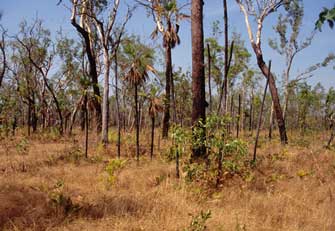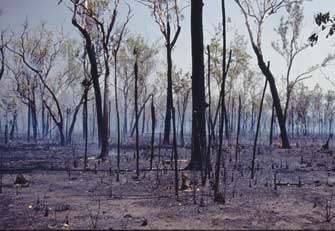Effects of fire on plants and animals: individual level
Plants
Obviously plants can’t move away when a fire comes through an area, so how are they able to survive and persist?
Most vegetative survival involves the protection of tissue from heat which would otherwise destroy it. Fire resistance and tolerance is exhibited through: bark thickness, other vegetative insulation, above-ground resprouting, underground roots and stems.
Bark thickness: Thick bark insulates and protects the cambium from heat and damage.
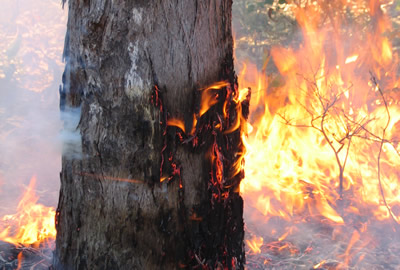
Thick bark protecting living tissue from fire
Vegetative insulation: Some protection is afforded by leaf sheaths. Grasses have meristems at leaf base so are protected from heat and damage in this way. Pandanus also receives some protection from leaf sheaths.

Leaf sheaths around shoots on Pandanus stems
Fire acts as a generalist herbivore removing plant material above the ground surface, thus enabling new herbaceous growth.
Above ground re-sprouting: While many trees are killed by total defoliation following a fire, some can re-sprout from epicormic buds, which are buds positioned beneath the bark. Eucalyptus trees are known for their ability to vegetatively regenerate branches along their trunks from buds. This is because epicormic buds of Eucalyptus trees are more protected than on other tree species because they are set much deeper at maximum bark thickness (Burrows 2002). The ability to survive and re-sprout depends on tree height, scorch and char heights, but also tree species, age, size (height) and the severity of the fire.
Ladder fires running up the trunks of these Melaleuca trees might look impressive but they can stimulate regrowth from epicormic buds and do not pose a threat to the trees.
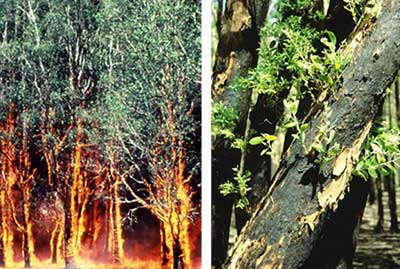
Melaleuca fire and epicormic re-sprouts
Below-ground roots and underground stems: Because soil is a good insulator, buds underground are well protected. Plants can survive fires by re-sprouting from basal stems, and also from roots and horizontal rhizomes.
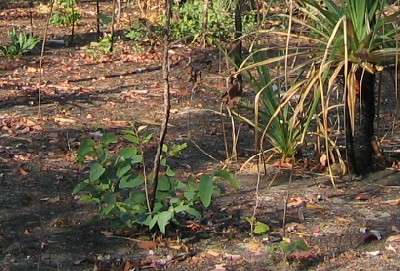
Re-sprouting Eucaluptus from lignotuber

Exocarpus resprouts after a fire
Root suckering can result in large clonal populations post-fire. Other plants have woody swellings at the base of their stems called lignotubers. They contain latent buds which are released from dormancy post-fire. Most Eucalyptus species have lignotubers. Geophytes survive burning because the storage organs are below ground protected from burning. They persist vegetatively between fires, and are stimulated to flower following a fire.
Activity: Individual plants and fire
What different strategies do plants have to survive fire?
On page 36 in Bond & van Wilgen (1996) is a good diagram and illustrations of the different responses that plants have to survive fire events.
Reading:
Bond, W.J. & van Wilgen, B.W. (1996) Fire and Plants, p.36. Chapman & Hall, London.
Further Reading
In the following paper the authors discuss traits which enable plants to survive fires and examine what this might mean for land use management in northern Australia.
Reading:
Lacey, C.J. & Whelan, P.I. (1976) Observations on the ecological significance of vegetation reproduction in the Katherine-Darwin region of the Northern Territory. Australian Forestry 39: 131-139.
Activity: Post-fire conditions
How has the habitat changed?
Look at the pictures below (pre- and post- fire in same habitat).
What kind of changes do you think that there might be to the environment post-fire?
Think about light availability, changes in nutrient levels, changes in competition, changes in micro-climate, hydrological changes, space, resources and predation pressure.
Can you draw a conceptual diagram indicating changes in light penetration and water movement (infiltration and runoff)? You might want to use arrows to indicate direction and the strength of the change.
Pre-fire habitat in the tropical savannas
Post-fire habitat in the tropical savannas
Conditions post-fire can be very different to those pre-fire, but contrary to the way things look, it's not all doom and gloom for plants. Many are stimulated to reproduce following a fire. A non-sprouting species with thin, flammable bark would not be expected to survive fires, but it can dominate flammable environments because it regenerates only after fire: its seed germination is cued to post-fire conditions.
Plant responses post-fire include:
- Increased productivity
- Increased flowering (especially of geophytes)
- Fire stimulated seed release and dispersal
- Improved seedling germination and establishment (through physical and chemical cues such as rupturing of seed coat/smoke & ash). Some seeds are dependent on fire for germination
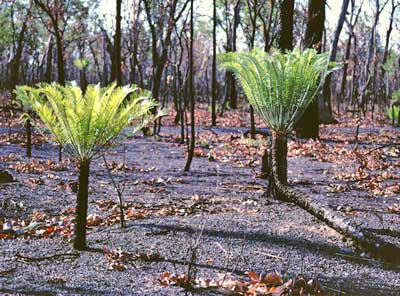
Cycads respond quickly after fires by pushing out fresh fronds
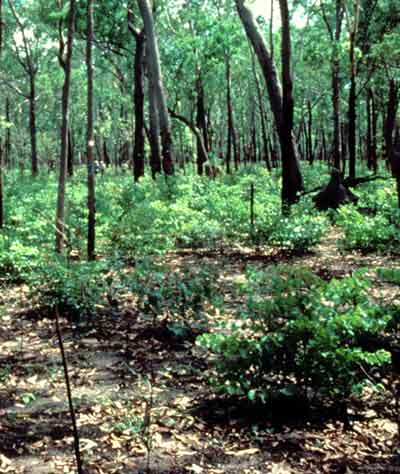
Re-sprouting from underground organs after a fire in Eucalyptus miniata and E. tetrodonta dominated woodland
Activity: More plant responses to fire
Are some species fire dependents?
Bond & van Wilgen (1996) provide more information on the responses of plants to fire.
Describe what serotiny is, and which plants in Australia display this condition? Think about why as a plant it may be beneficial to be serotinous.
Describe how responses to fire might vary for ephemerals, obligate seeders and sprouters?
Reading:
Bond, W.J. & van Wilgen, B.W. (1996) Fire and Plants, pp.42-38. Chapman & Hall, London.
There is an important distinction to make between vegetation responses to fire in northern and southern Australia. In southern Australia, Eucalyptus has fire promoting characteristics such as highly flammable leaves and bark, and fire is very often required for seed release. This contrasts with the situation across much of the northern savannas where vegetation lacks most of these characteristics, and serotiny is rare. Savanna vegetation tends to be very resilient to burning, with vegetation recovery very quick either vegetatively or by seed.
Animals
Since fire has occurred in Australia for thousands of years, fauna in fire-prone areas are relatively tolerant of it, and have developed a range of responses to fire. These include avoidance of fire by seeking refuge on unburned patches or moving out of the area entirely, burrowing into soil to escape heat, and active use of the fire and burnt areas for feeding, or as cues for breeding (e.g. birds). Fire acts on fauna exerting both direct and indirect effects.
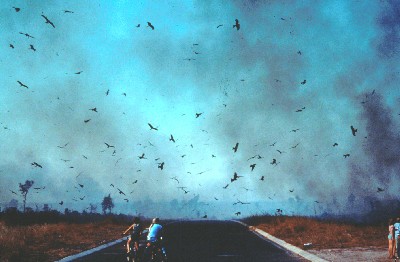
Kites circle near the fire front to target small animals that are flushed from hiding or that are killed during the fire
Direct effects
Mortality, a major direct effect of fire, is generally low because most animals move out of the affected area. Mortality is likely to be higher in flightless invertebrates, and also some insects in vulnerable stages of development (e.g. larval stages). Dispersal is often an immediate reaction to fire, and it is an important cause of change in the composition of fauna at a site.
Indirect effects
Indirect effects of fire are related to the alteration of the physical environment. Fire alters vegetation structure and composition, and can result in changes in resource availability for fauna. This can lead to
- changes in food quantity and quality (e.g. an abundance of dead insects for birds to feed on, or more nutritious fresh new grass for herbivores)
- cover and micro-site characteristics (e.g. soil moisture, ground temperature)
These environmental changes then affect faunal populations.
Another indirect effect of fire is that some species may utilize the burned open areas to reduce predation risk since visibility is improved. Conversely, other species may become more vulnerable to predation because of loss of shelter. Some species of birds that use recently burnt areas for nesting have camouflaged eggs that blend in with the burnt ground and appear less obvious to predators.
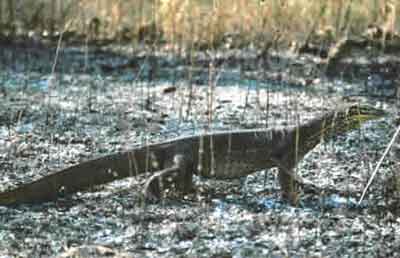
Goannas scavenge for dead animals in newly burned areas
![]()
